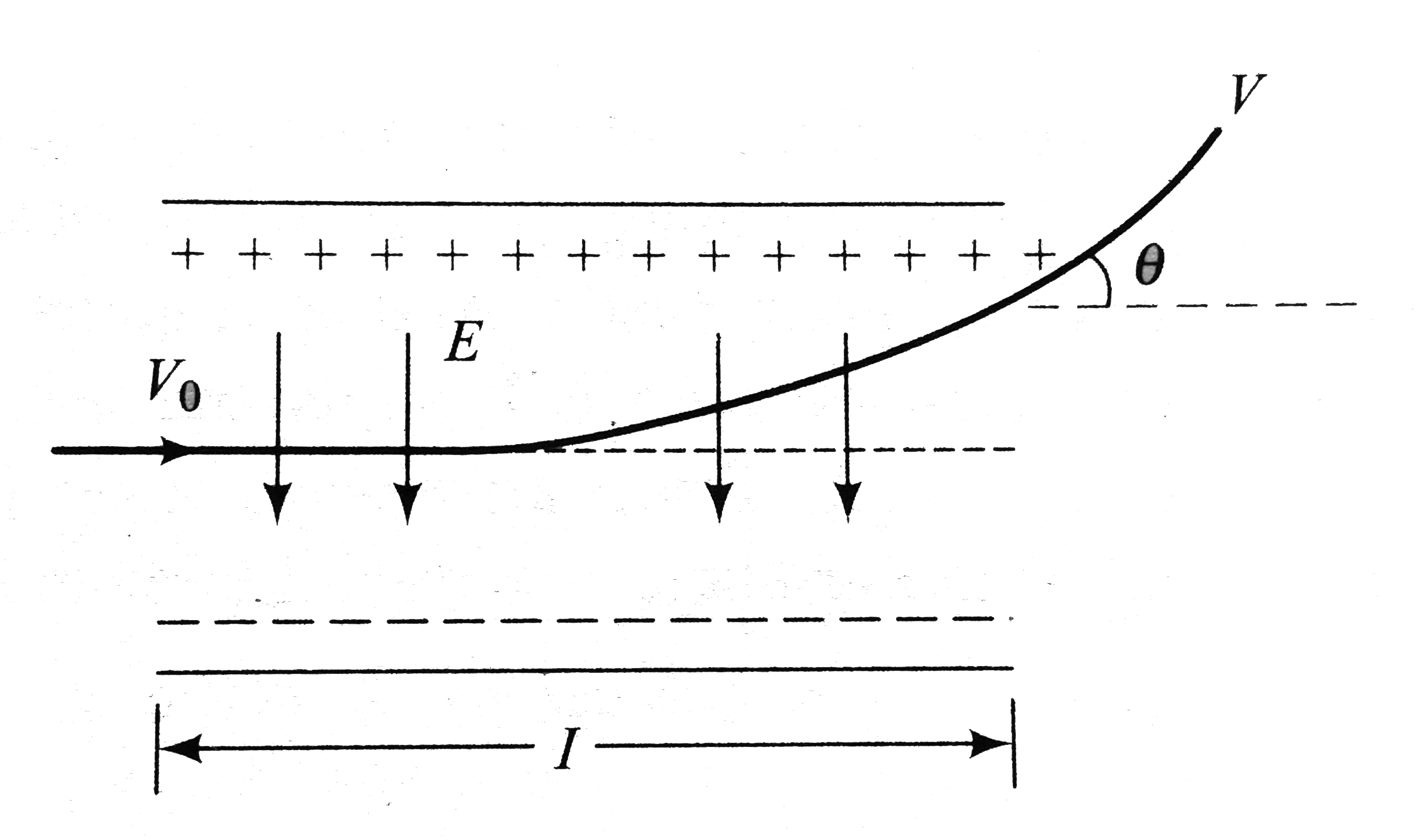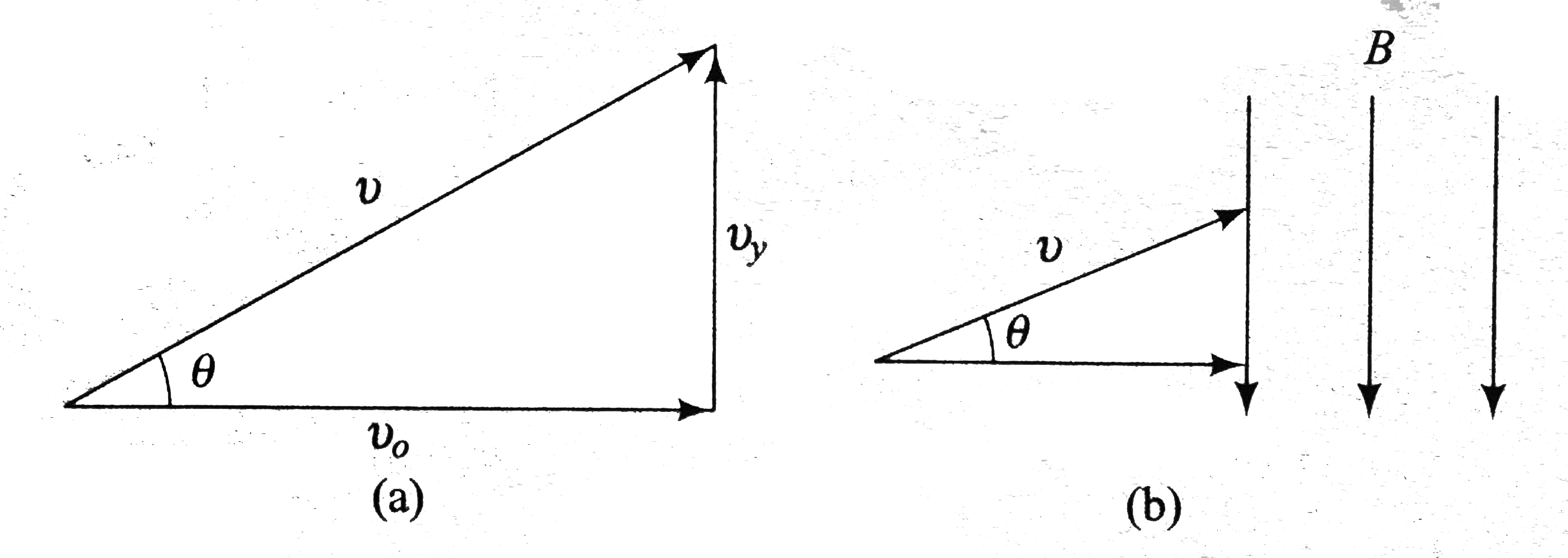An electron accelerated by a potential difference volt first enters into a uniform electric field of a parallel plate capacitor whose plates extend over a length in the direction of initial velocity. The electric field is normal to the direction of initial velocity and its strength varies with time as where Then the electron enters into a uniform magnetic field of induction Direction of magnetic field is same as that of the electric field. Calculate pitch of helical path traced by the electron in the magnetic field. (Mass of electron, )
Since, electron is accelerated thorugh a potential difference
V, therefore, its initial velcity is given by
Since, initial velocity is paralle to plates or normal to the
direction of electric field, therefore, component of velocity
parallel to plates remains constant as .

Hence, time taken by the electron to cross the electric field is
Now consider motion of electron , normal to plates.
At some instant t, its acceleration
Let velocity component normal to plates to
Then this acceleration is equal to
or
But at initial moment
Angular deviation of electron form its initial direction of motion is shown in Fig.
Now electron enters into magnetic field. Pitch of its helical path

.
Topper's Solved these Questions
- MAGNETIC FIELD AND MAGNETIC FORCESBook:CENGAGE PHYSICSChapter:MAGNETIC FIELD AND MAGNETIC FORCESExercise:Exercise 1.1
Explore 22 Videos
- MAGNETIC FIELD AND MAGNETIC FORCESBook:CENGAGE PHYSICSChapter:MAGNETIC FIELD AND MAGNETIC FORCESExercise:Exercise 1.2
Explore 13 Videos
- MAGNETIC FIELD AND MAGNETIC FORCESBook:CENGAGE PHYSICSChapter:MAGNETIC FIELD AND MAGNETIC FORCESExercise:Multiple Correct Answer type
Explore 2 Videos
- KINETIC THEORYBook:CENGAGE PHYSICSChapter:KINETIC THEORYExercise:Question Bank
Explore 31 Videos
- Magnetism and MatterBook:CENGAGE PHYSICSChapter:Magnetism and MatterExercise:Question Bank
Explore 50 Videos
Similar Questions
A proton of mass m and accelerated by a potential difference Vgets into a uniform electric field of a parallel plate capacitor parallel to plates of length 1 at mid-point of its separation between plates. The field strength in it varies with time as E = at, where a is a positive constant. Find the angle of deviation of the proton as it comes out of the capacitor. (Assume that it does not collide with any of the plates.)
View SolutionA proton accelarted by a potential differnce V gets into the unifrom electric field of a paralallel-plate capacitor whose plates extended over a length l in the motion direction. The field strenth varies with time as E=at, where a is a constant. Assuming the proton to be non-relatistic, find the angle between the motion directions of the proton before and after its fight throgh the capacitor, the proton gets in the field at the moment t=0. The edge effects are to be neglected.
View Solution
Knowledge Check
For uniform electric field, potential difference between the plate is
A1ε0QAdB1ε0AdQCε0QAdD1ε0QdAA electron e− is accelerated by V volts experiences a force F, when it enters in a uniform magnetic field. What will the force experienced when it is accelerated by 2V?
A√2FBFC2FDF2An electron enters in an electric field with its velocity in the direction of the electric lines of force. Then
AThe path of the electron will be a circleBThe path of the electron will be a parabolaCThe velocity of the electron will decreaseDThe velocity of the electron will increase
An electron after being accelerated through a potential difference of 100 V enters a uniform magnetic field of 0⋅004T, perpendicular to its direction of motion. Calculate the radius of the path described by the electron.
View SolutionAn electron emitted by heated cathode and accelerated through a potential difference of 2.0 kV, enters a region with uniform magnetic field of 0.15 T. Determine the trajectory of the electron if the field (a) is transverse to its initial velocity , (b) makes an angle of 30∘ with the initial velocity.
View SolutionAn electron emmited by a heated cathode and accelerated through a potential difference of 2⋅0kV enters a region with a uniform magnetic field of 0⋅15T. Determine the trajectory of the electron if the field (a) is transverse to its initial velocity (b) makes an angle of 30∘ with the initial velocity.
View SolutionA n electrically charged particle enters into a uniform magnetic induction field in a direction perpendicular to the field with a velocity v then it travels
View SolutionIf an electron has an initial velocity in a direction different from that of an electric field, then the path of the electron is
View Solution
